Financial Resources and Decision Analysis
VerifiedAdded on 2019/12/28
|17
|5168
|205
Report
AI Summary
This assignment content consists of a list of academic papers and online resources related to financial management, accounting, and decision-making. The papers cover various topics such as innovative sources of development finance, fetal lung maturity prediction, budget analysis, personal financial planning attitudes, intellectual capital disclosure, and enterprise risk management. The online resources include articles on managing financial resources, ratio analysis, and medium-term borrowing.
Contribute Materials
Your contribution can guide someone’s learning journey. Share your
documents today.
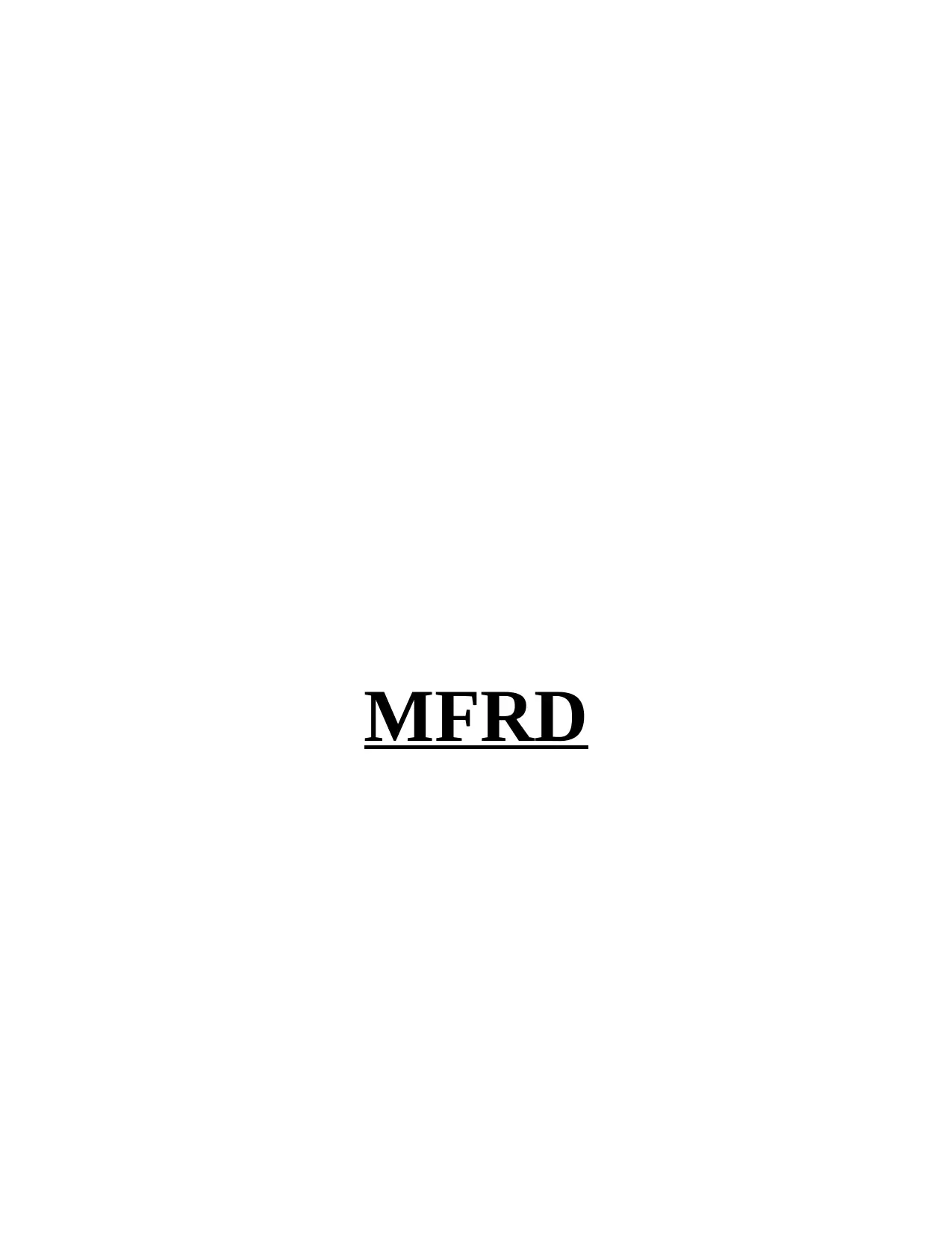
MFRD
Secure Best Marks with AI Grader
Need help grading? Try our AI Grader for instant feedback on your assignments.
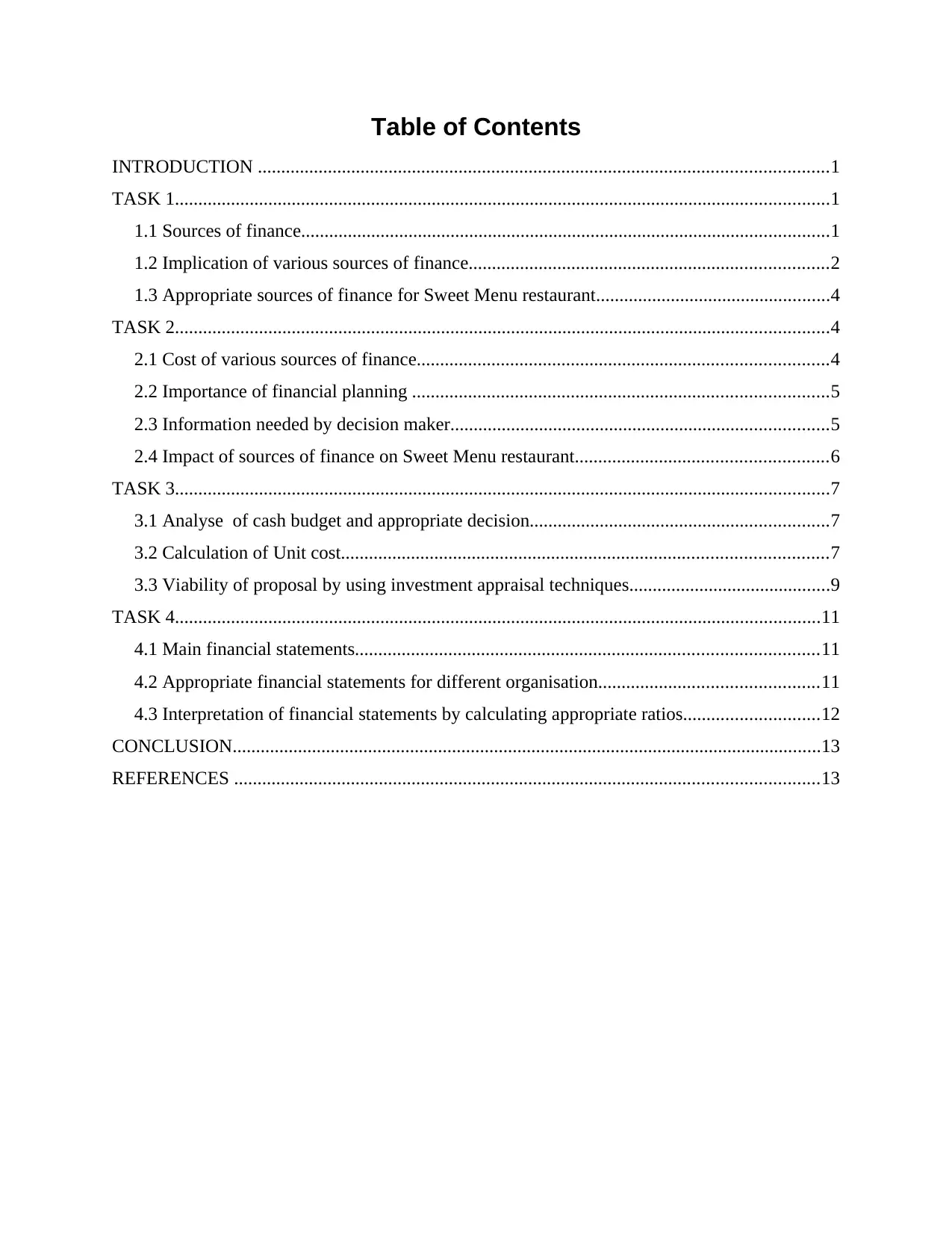
Table of Contents
INTRODUCTION ..........................................................................................................................1
TASK 1............................................................................................................................................1
1.1 Sources of finance.................................................................................................................1
1.2 Implication of various sources of finance.............................................................................2
1.3 Appropriate sources of finance for Sweet Menu restaurant..................................................4
TASK 2............................................................................................................................................4
2.1 Cost of various sources of finance........................................................................................4
2.2 Importance of financial planning .........................................................................................5
2.3 Information needed by decision maker.................................................................................5
2.4 Impact of sources of finance on Sweet Menu restaurant......................................................6
TASK 3............................................................................................................................................7
3.1 Analyse of cash budget and appropriate decision................................................................7
3.2 Calculation of Unit cost........................................................................................................7
3.3 Viability of proposal by using investment appraisal techniques...........................................9
TASK 4..........................................................................................................................................11
4.1 Main financial statements...................................................................................................11
4.2 Appropriate financial statements for different organisation...............................................11
4.3 Interpretation of financial statements by calculating appropriate ratios.............................12
CONCLUSION..............................................................................................................................13
REFERENCES .............................................................................................................................13
INTRODUCTION ..........................................................................................................................1
TASK 1............................................................................................................................................1
1.1 Sources of finance.................................................................................................................1
1.2 Implication of various sources of finance.............................................................................2
1.3 Appropriate sources of finance for Sweet Menu restaurant..................................................4
TASK 2............................................................................................................................................4
2.1 Cost of various sources of finance........................................................................................4
2.2 Importance of financial planning .........................................................................................5
2.3 Information needed by decision maker.................................................................................5
2.4 Impact of sources of finance on Sweet Menu restaurant......................................................6
TASK 3............................................................................................................................................7
3.1 Analyse of cash budget and appropriate decision................................................................7
3.2 Calculation of Unit cost........................................................................................................7
3.3 Viability of proposal by using investment appraisal techniques...........................................9
TASK 4..........................................................................................................................................11
4.1 Main financial statements...................................................................................................11
4.2 Appropriate financial statements for different organisation...............................................11
4.3 Interpretation of financial statements by calculating appropriate ratios.............................12
CONCLUSION..............................................................................................................................13
REFERENCES .............................................................................................................................13
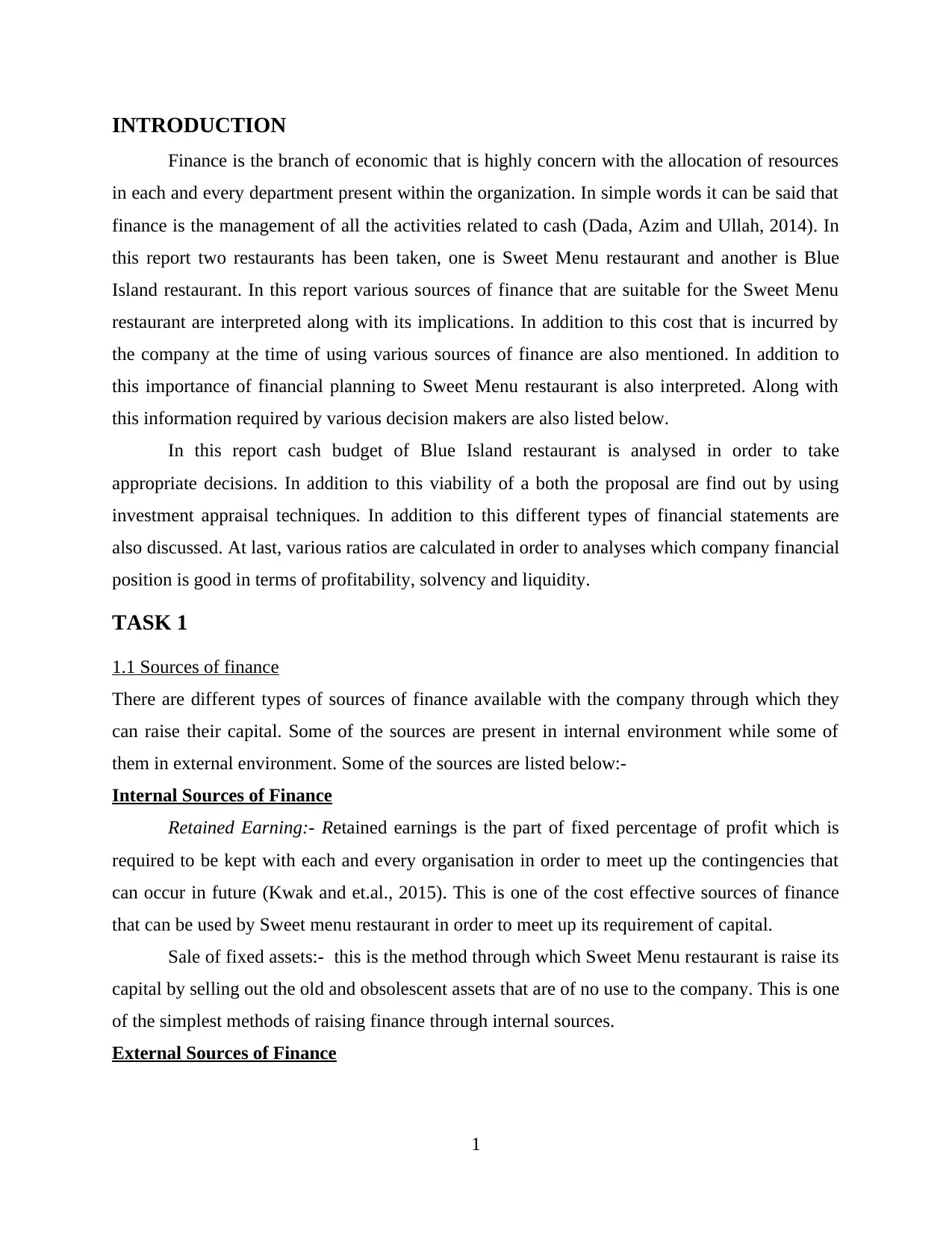
INTRODUCTION
Finance is the branch of economic that is highly concern with the allocation of resources
in each and every department present within the organization. In simple words it can be said that
finance is the management of all the activities related to cash (Dada, Azim and Ullah, 2014). In
this report two restaurants has been taken, one is Sweet Menu restaurant and another is Blue
Island restaurant. In this report various sources of finance that are suitable for the Sweet Menu
restaurant are interpreted along with its implications. In addition to this cost that is incurred by
the company at the time of using various sources of finance are also mentioned. In addition to
this importance of financial planning to Sweet Menu restaurant is also interpreted. Along with
this information required by various decision makers are also listed below.
In this report cash budget of Blue Island restaurant is analysed in order to take
appropriate decisions. In addition to this viability of a both the proposal are find out by using
investment appraisal techniques. In addition to this different types of financial statements are
also discussed. At last, various ratios are calculated in order to analyses which company financial
position is good in terms of profitability, solvency and liquidity.
TASK 1
1.1 Sources of finance
There are different types of sources of finance available with the company through which they
can raise their capital. Some of the sources are present in internal environment while some of
them in external environment. Some of the sources are listed below:-
Internal Sources of Finance
Retained Earning:- Retained earnings is the part of fixed percentage of profit which is
required to be kept with each and every organisation in order to meet up the contingencies that
can occur in future (Kwak and et.al., 2015). This is one of the cost effective sources of finance
that can be used by Sweet menu restaurant in order to meet up its requirement of capital.
Sale of fixed assets:- this is the method through which Sweet Menu restaurant is raise its
capital by selling out the old and obsolescent assets that are of no use to the company. This is one
of the simplest methods of raising finance through internal sources.
External Sources of Finance
1
Finance is the branch of economic that is highly concern with the allocation of resources
in each and every department present within the organization. In simple words it can be said that
finance is the management of all the activities related to cash (Dada, Azim and Ullah, 2014). In
this report two restaurants has been taken, one is Sweet Menu restaurant and another is Blue
Island restaurant. In this report various sources of finance that are suitable for the Sweet Menu
restaurant are interpreted along with its implications. In addition to this cost that is incurred by
the company at the time of using various sources of finance are also mentioned. In addition to
this importance of financial planning to Sweet Menu restaurant is also interpreted. Along with
this information required by various decision makers are also listed below.
In this report cash budget of Blue Island restaurant is analysed in order to take
appropriate decisions. In addition to this viability of a both the proposal are find out by using
investment appraisal techniques. In addition to this different types of financial statements are
also discussed. At last, various ratios are calculated in order to analyses which company financial
position is good in terms of profitability, solvency and liquidity.
TASK 1
1.1 Sources of finance
There are different types of sources of finance available with the company through which they
can raise their capital. Some of the sources are present in internal environment while some of
them in external environment. Some of the sources are listed below:-
Internal Sources of Finance
Retained Earning:- Retained earnings is the part of fixed percentage of profit which is
required to be kept with each and every organisation in order to meet up the contingencies that
can occur in future (Kwak and et.al., 2015). This is one of the cost effective sources of finance
that can be used by Sweet menu restaurant in order to meet up its requirement of capital.
Sale of fixed assets:- this is the method through which Sweet Menu restaurant is raise its
capital by selling out the old and obsolescent assets that are of no use to the company. This is one
of the simplest methods of raising finance through internal sources.
External Sources of Finance
1
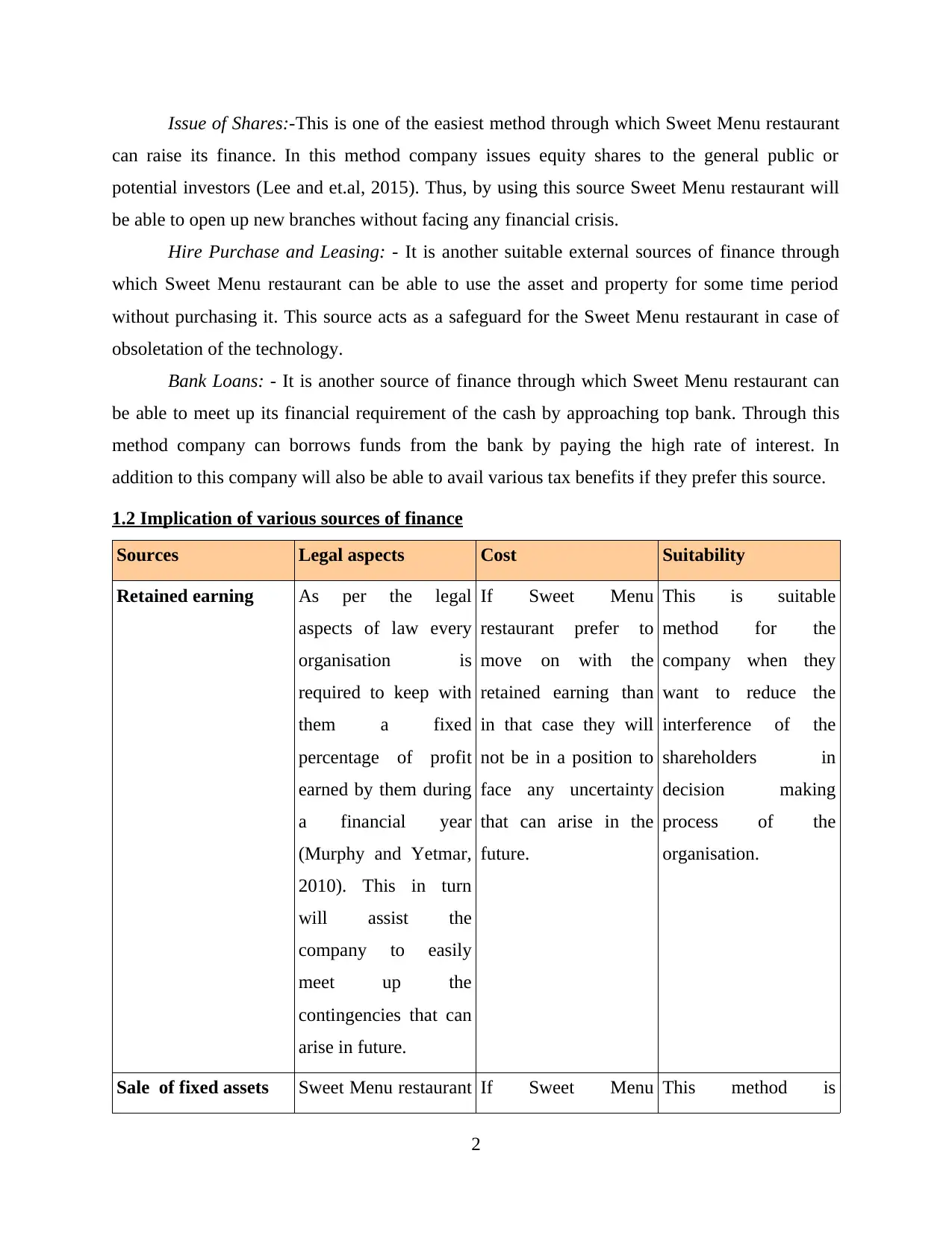
Issue of Shares:-This is one of the easiest method through which Sweet Menu restaurant
can raise its finance. In this method company issues equity shares to the general public or
potential investors (Lee and et.al, 2015). Thus, by using this source Sweet Menu restaurant will
be able to open up new branches without facing any financial crisis.
Hire Purchase and Leasing: - It is another suitable external sources of finance through
which Sweet Menu restaurant can be able to use the asset and property for some time period
without purchasing it. This source acts as a safeguard for the Sweet Menu restaurant in case of
obsoletation of the technology.
Bank Loans: - It is another source of finance through which Sweet Menu restaurant can
be able to meet up its financial requirement of the cash by approaching top bank. Through this
method company can borrows funds from the bank by paying the high rate of interest. In
addition to this company will also be able to avail various tax benefits if they prefer this source.
1.2 Implication of various sources of finance
Sources Legal aspects Cost Suitability
Retained earning As per the legal
aspects of law every
organisation is
required to keep with
them a fixed
percentage of profit
earned by them during
a financial year
(Murphy and Yetmar,
2010). This in turn
will assist the
company to easily
meet up the
contingencies that can
arise in future.
If Sweet Menu
restaurant prefer to
move on with the
retained earning than
in that case they will
not be in a position to
face any uncertainty
that can arise in the
future.
This is suitable
method for the
company when they
want to reduce the
interference of the
shareholders in
decision making
process of the
organisation.
Sale of fixed assets Sweet Menu restaurant If Sweet Menu This method is
2
can raise its finance. In this method company issues equity shares to the general public or
potential investors (Lee and et.al, 2015). Thus, by using this source Sweet Menu restaurant will
be able to open up new branches without facing any financial crisis.
Hire Purchase and Leasing: - It is another suitable external sources of finance through
which Sweet Menu restaurant can be able to use the asset and property for some time period
without purchasing it. This source acts as a safeguard for the Sweet Menu restaurant in case of
obsoletation of the technology.
Bank Loans: - It is another source of finance through which Sweet Menu restaurant can
be able to meet up its financial requirement of the cash by approaching top bank. Through this
method company can borrows funds from the bank by paying the high rate of interest. In
addition to this company will also be able to avail various tax benefits if they prefer this source.
1.2 Implication of various sources of finance
Sources Legal aspects Cost Suitability
Retained earning As per the legal
aspects of law every
organisation is
required to keep with
them a fixed
percentage of profit
earned by them during
a financial year
(Murphy and Yetmar,
2010). This in turn
will assist the
company to easily
meet up the
contingencies that can
arise in future.
If Sweet Menu
restaurant prefer to
move on with the
retained earning than
in that case they will
not be in a position to
face any uncertainty
that can arise in the
future.
This is suitable
method for the
company when they
want to reduce the
interference of the
shareholders in
decision making
process of the
organisation.
Sale of fixed assets Sweet Menu restaurant If Sweet Menu This method is
2
Secure Best Marks with AI Grader
Need help grading? Try our AI Grader for instant feedback on your assignments.
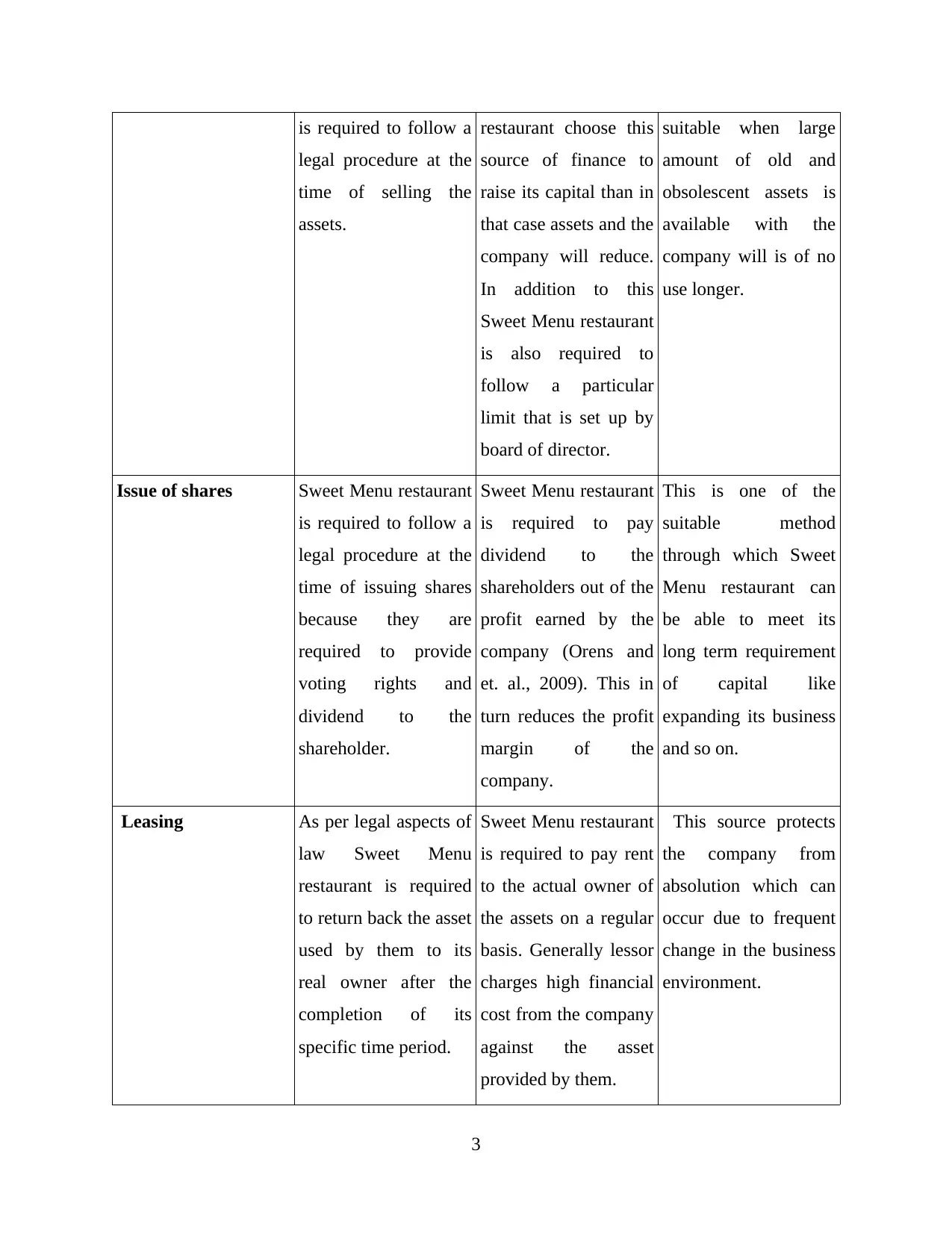
is required to follow a
legal procedure at the
time of selling the
assets.
restaurant choose this
source of finance to
raise its capital than in
that case assets and the
company will reduce.
In addition to this
Sweet Menu restaurant
is also required to
follow a particular
limit that is set up by
board of director.
suitable when large
amount of old and
obsolescent assets is
available with the
company will is of no
use longer.
Issue of shares Sweet Menu restaurant
is required to follow a
legal procedure at the
time of issuing shares
because they are
required to provide
voting rights and
dividend to the
shareholder.
Sweet Menu restaurant
is required to pay
dividend to the
shareholders out of the
profit earned by the
company (Orens and
et. al., 2009). This in
turn reduces the profit
margin of the
company.
This is one of the
suitable method
through which Sweet
Menu restaurant can
be able to meet its
long term requirement
of capital like
expanding its business
and so on.
Leasing As per legal aspects of
law Sweet Menu
restaurant is required
to return back the asset
used by them to its
real owner after the
completion of its
specific time period.
Sweet Menu restaurant
is required to pay rent
to the actual owner of
the assets on a regular
basis. Generally lessor
charges high financial
cost from the company
against the asset
provided by them.
This source protects
the company from
absolution which can
occur due to frequent
change in the business
environment.
3
legal procedure at the
time of selling the
assets.
restaurant choose this
source of finance to
raise its capital than in
that case assets and the
company will reduce.
In addition to this
Sweet Menu restaurant
is also required to
follow a particular
limit that is set up by
board of director.
suitable when large
amount of old and
obsolescent assets is
available with the
company will is of no
use longer.
Issue of shares Sweet Menu restaurant
is required to follow a
legal procedure at the
time of issuing shares
because they are
required to provide
voting rights and
dividend to the
shareholder.
Sweet Menu restaurant
is required to pay
dividend to the
shareholders out of the
profit earned by the
company (Orens and
et. al., 2009). This in
turn reduces the profit
margin of the
company.
This is one of the
suitable method
through which Sweet
Menu restaurant can
be able to meet its
long term requirement
of capital like
expanding its business
and so on.
Leasing As per legal aspects of
law Sweet Menu
restaurant is required
to return back the asset
used by them to its
real owner after the
completion of its
specific time period.
Sweet Menu restaurant
is required to pay rent
to the actual owner of
the assets on a regular
basis. Generally lessor
charges high financial
cost from the company
against the asset
provided by them.
This source protects
the company from
absolution which can
occur due to frequent
change in the business
environment.
3
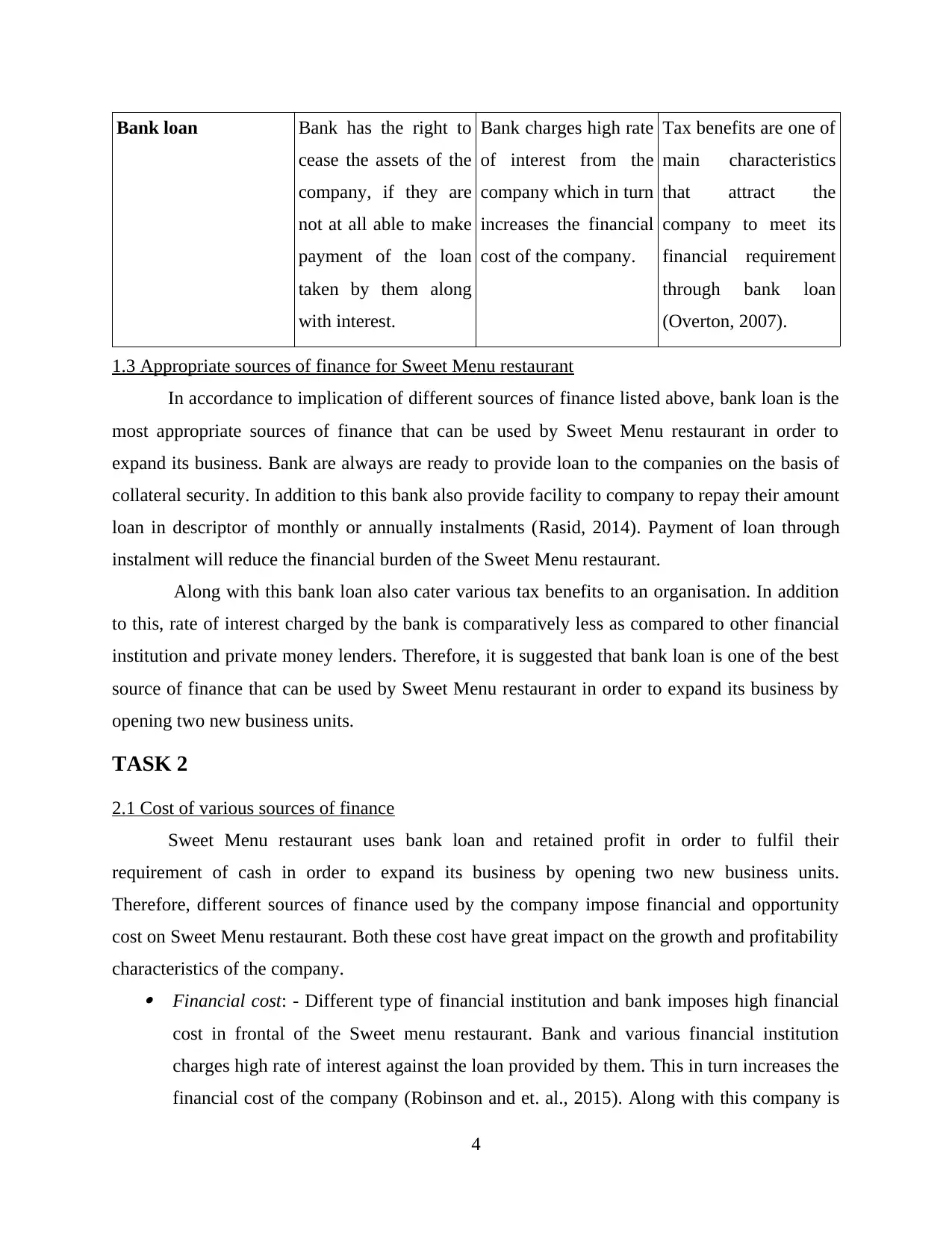
Bank loan Bank has the right to
cease the assets of the
company, if they are
not at all able to make
payment of the loan
taken by them along
with interest.
Bank charges high rate
of interest from the
company which in turn
increases the financial
cost of the company.
Tax benefits are one of
main characteristics
that attract the
company to meet its
financial requirement
through bank loan
(Overton, 2007).
1.3 Appropriate sources of finance for Sweet Menu restaurant
In accordance to implication of different sources of finance listed above, bank loan is the
most appropriate sources of finance that can be used by Sweet Menu restaurant in order to
expand its business. Bank are always are ready to provide loan to the companies on the basis of
collateral security. In addition to this bank also provide facility to company to repay their amount
loan in descriptor of monthly or annually instalments (Rasid, 2014). Payment of loan through
instalment will reduce the financial burden of the Sweet Menu restaurant.
Along with this bank loan also cater various tax benefits to an organisation. In addition
to this, rate of interest charged by the bank is comparatively less as compared to other financial
institution and private money lenders. Therefore, it is suggested that bank loan is one of the best
source of finance that can be used by Sweet Menu restaurant in order to expand its business by
opening two new business units.
TASK 2
2.1 Cost of various sources of finance
Sweet Menu restaurant uses bank loan and retained profit in order to fulfil their
requirement of cash in order to expand its business by opening two new business units.
Therefore, different sources of finance used by the company impose financial and opportunity
cost on Sweet Menu restaurant. Both these cost have great impact on the growth and profitability
characteristics of the company. Financial cost: - Different type of financial institution and bank imposes high financial
cost in frontal of the Sweet menu restaurant. Bank and various financial institution
charges high rate of interest against the loan provided by them. This in turn increases the
financial cost of the company (Robinson and et. al., 2015). Along with this company is
4
cease the assets of the
company, if they are
not at all able to make
payment of the loan
taken by them along
with interest.
Bank charges high rate
of interest from the
company which in turn
increases the financial
cost of the company.
Tax benefits are one of
main characteristics
that attract the
company to meet its
financial requirement
through bank loan
(Overton, 2007).
1.3 Appropriate sources of finance for Sweet Menu restaurant
In accordance to implication of different sources of finance listed above, bank loan is the
most appropriate sources of finance that can be used by Sweet Menu restaurant in order to
expand its business. Bank are always are ready to provide loan to the companies on the basis of
collateral security. In addition to this bank also provide facility to company to repay their amount
loan in descriptor of monthly or annually instalments (Rasid, 2014). Payment of loan through
instalment will reduce the financial burden of the Sweet Menu restaurant.
Along with this bank loan also cater various tax benefits to an organisation. In addition
to this, rate of interest charged by the bank is comparatively less as compared to other financial
institution and private money lenders. Therefore, it is suggested that bank loan is one of the best
source of finance that can be used by Sweet Menu restaurant in order to expand its business by
opening two new business units.
TASK 2
2.1 Cost of various sources of finance
Sweet Menu restaurant uses bank loan and retained profit in order to fulfil their
requirement of cash in order to expand its business by opening two new business units.
Therefore, different sources of finance used by the company impose financial and opportunity
cost on Sweet Menu restaurant. Both these cost have great impact on the growth and profitability
characteristics of the company. Financial cost: - Different type of financial institution and bank imposes high financial
cost in frontal of the Sweet menu restaurant. Bank and various financial institution
charges high rate of interest against the loan provided by them. This in turn increases the
financial cost of the company (Robinson and et. al., 2015). Along with this company is
4
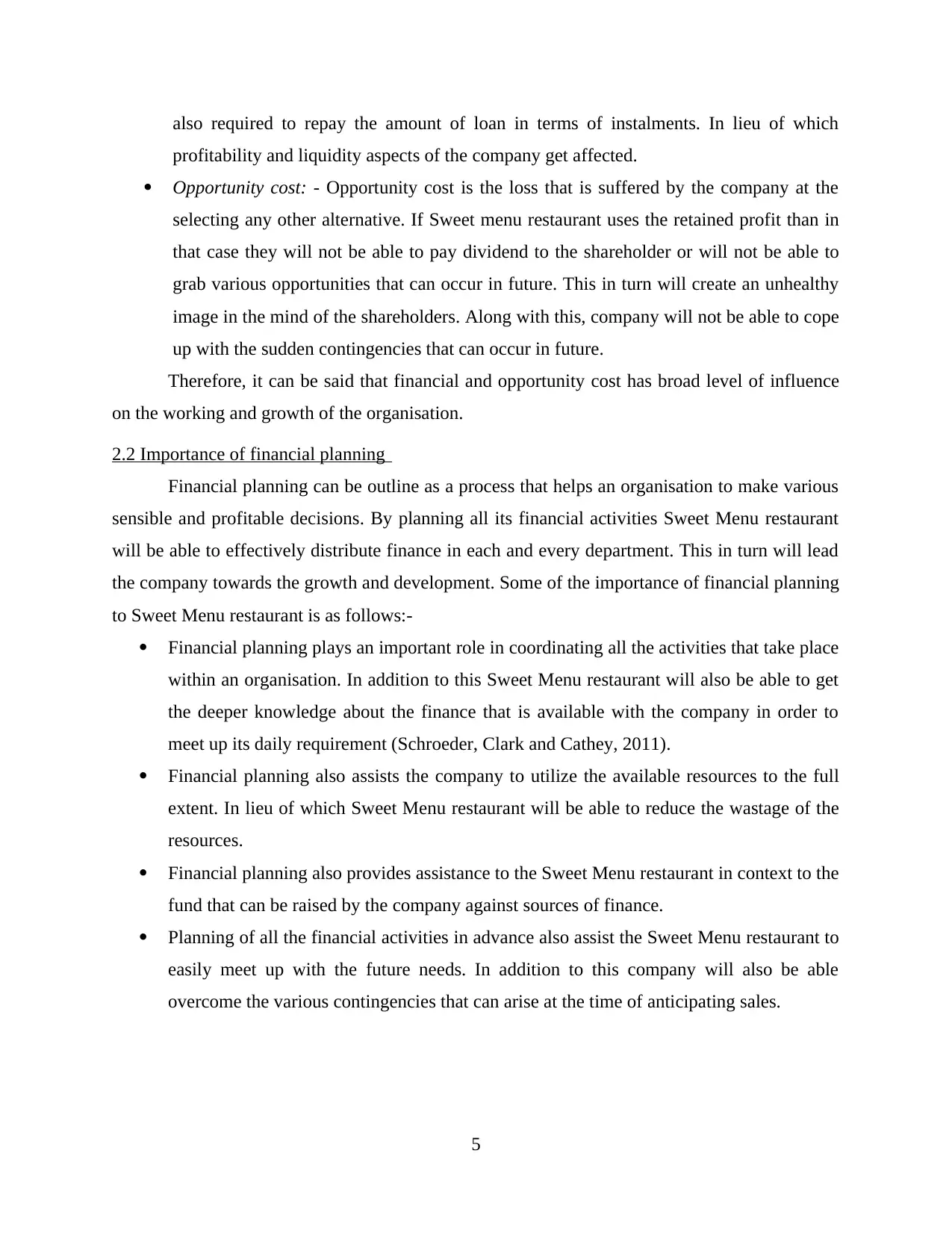
also required to repay the amount of loan in terms of instalments. In lieu of which
profitability and liquidity aspects of the company get affected.
Opportunity cost: - Opportunity cost is the loss that is suffered by the company at the
selecting any other alternative. If Sweet menu restaurant uses the retained profit than in
that case they will not be able to pay dividend to the shareholder or will not be able to
grab various opportunities that can occur in future. This in turn will create an unhealthy
image in the mind of the shareholders. Along with this, company will not be able to cope
up with the sudden contingencies that can occur in future.
Therefore, it can be said that financial and opportunity cost has broad level of influence
on the working and growth of the organisation.
2.2 Importance of financial planning
Financial planning can be outline as a process that helps an organisation to make various
sensible and profitable decisions. By planning all its financial activities Sweet Menu restaurant
will be able to effectively distribute finance in each and every department. This in turn will lead
the company towards the growth and development. Some of the importance of financial planning
to Sweet Menu restaurant is as follows:-
Financial planning plays an important role in coordinating all the activities that take place
within an organisation. In addition to this Sweet Menu restaurant will also be able to get
the deeper knowledge about the finance that is available with the company in order to
meet up its daily requirement (Schroeder, Clark and Cathey, 2011).
Financial planning also assists the company to utilize the available resources to the full
extent. In lieu of which Sweet Menu restaurant will be able to reduce the wastage of the
resources.
Financial planning also provides assistance to the Sweet Menu restaurant in context to the
fund that can be raised by the company against sources of finance.
Planning of all the financial activities in advance also assist the Sweet Menu restaurant to
easily meet up with the future needs. In addition to this company will also be able
overcome the various contingencies that can arise at the time of anticipating sales.
5
profitability and liquidity aspects of the company get affected.
Opportunity cost: - Opportunity cost is the loss that is suffered by the company at the
selecting any other alternative. If Sweet menu restaurant uses the retained profit than in
that case they will not be able to pay dividend to the shareholder or will not be able to
grab various opportunities that can occur in future. This in turn will create an unhealthy
image in the mind of the shareholders. Along with this, company will not be able to cope
up with the sudden contingencies that can occur in future.
Therefore, it can be said that financial and opportunity cost has broad level of influence
on the working and growth of the organisation.
2.2 Importance of financial planning
Financial planning can be outline as a process that helps an organisation to make various
sensible and profitable decisions. By planning all its financial activities Sweet Menu restaurant
will be able to effectively distribute finance in each and every department. This in turn will lead
the company towards the growth and development. Some of the importance of financial planning
to Sweet Menu restaurant is as follows:-
Financial planning plays an important role in coordinating all the activities that take place
within an organisation. In addition to this Sweet Menu restaurant will also be able to get
the deeper knowledge about the finance that is available with the company in order to
meet up its daily requirement (Schroeder, Clark and Cathey, 2011).
Financial planning also assists the company to utilize the available resources to the full
extent. In lieu of which Sweet Menu restaurant will be able to reduce the wastage of the
resources.
Financial planning also provides assistance to the Sweet Menu restaurant in context to the
fund that can be raised by the company against sources of finance.
Planning of all the financial activities in advance also assist the Sweet Menu restaurant to
easily meet up with the future needs. In addition to this company will also be able
overcome the various contingencies that can arise at the time of anticipating sales.
5
Paraphrase This Document
Need a fresh take? Get an instant paraphrase of this document with our AI Paraphraser
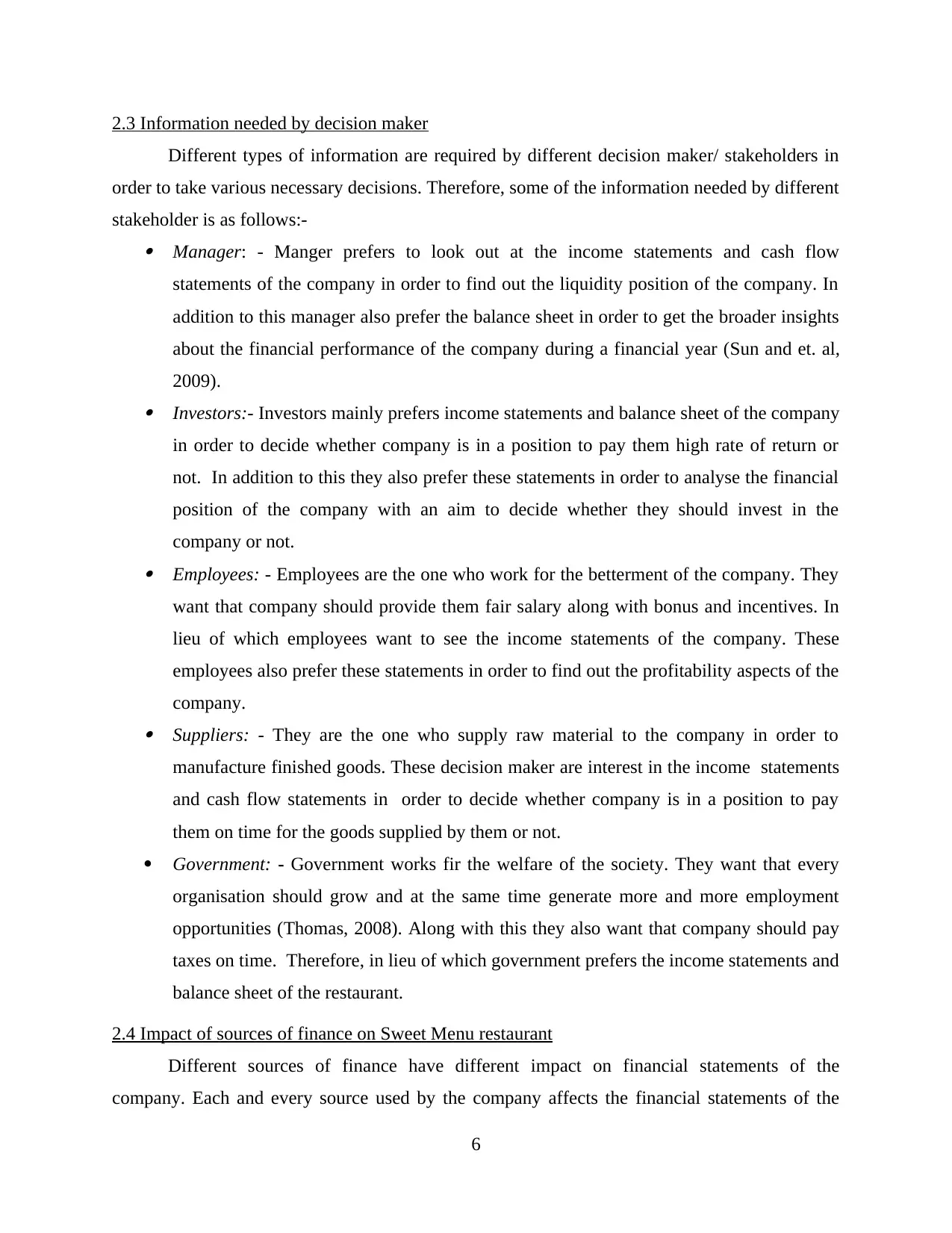
2.3 Information needed by decision maker
Different types of information are required by different decision maker/ stakeholders in
order to take various necessary decisions. Therefore, some of the information needed by different
stakeholder is as follows:- Manager: - Manger prefers to look out at the income statements and cash flow
statements of the company in order to find out the liquidity position of the company. In
addition to this manager also prefer the balance sheet in order to get the broader insights
about the financial performance of the company during a financial year (Sun and et. al,
2009). Investors:- Investors mainly prefers income statements and balance sheet of the company
in order to decide whether company is in a position to pay them high rate of return or
not. In addition to this they also prefer these statements in order to analyse the financial
position of the company with an aim to decide whether they should invest in the
company or not. Employees: - Employees are the one who work for the betterment of the company. They
want that company should provide them fair salary along with bonus and incentives. In
lieu of which employees want to see the income statements of the company. These
employees also prefer these statements in order to find out the profitability aspects of the
company. Suppliers: - They are the one who supply raw material to the company in order to
manufacture finished goods. These decision maker are interest in the income statements
and cash flow statements in order to decide whether company is in a position to pay
them on time for the goods supplied by them or not.
Government: - Government works fir the welfare of the society. They want that every
organisation should grow and at the same time generate more and more employment
opportunities (Thomas, 2008). Along with this they also want that company should pay
taxes on time. Therefore, in lieu of which government prefers the income statements and
balance sheet of the restaurant.
2.4 Impact of sources of finance on Sweet Menu restaurant
Different sources of finance have different impact on financial statements of the
company. Each and every source used by the company affects the financial statements of the
6
Different types of information are required by different decision maker/ stakeholders in
order to take various necessary decisions. Therefore, some of the information needed by different
stakeholder is as follows:- Manager: - Manger prefers to look out at the income statements and cash flow
statements of the company in order to find out the liquidity position of the company. In
addition to this manager also prefer the balance sheet in order to get the broader insights
about the financial performance of the company during a financial year (Sun and et. al,
2009). Investors:- Investors mainly prefers income statements and balance sheet of the company
in order to decide whether company is in a position to pay them high rate of return or
not. In addition to this they also prefer these statements in order to analyse the financial
position of the company with an aim to decide whether they should invest in the
company or not. Employees: - Employees are the one who work for the betterment of the company. They
want that company should provide them fair salary along with bonus and incentives. In
lieu of which employees want to see the income statements of the company. These
employees also prefer these statements in order to find out the profitability aspects of the
company. Suppliers: - They are the one who supply raw material to the company in order to
manufacture finished goods. These decision maker are interest in the income statements
and cash flow statements in order to decide whether company is in a position to pay
them on time for the goods supplied by them or not.
Government: - Government works fir the welfare of the society. They want that every
organisation should grow and at the same time generate more and more employment
opportunities (Thomas, 2008). Along with this they also want that company should pay
taxes on time. Therefore, in lieu of which government prefers the income statements and
balance sheet of the restaurant.
2.4 Impact of sources of finance on Sweet Menu restaurant
Different sources of finance have different impact on financial statements of the
company. Each and every source used by the company affects the financial statements of the
6
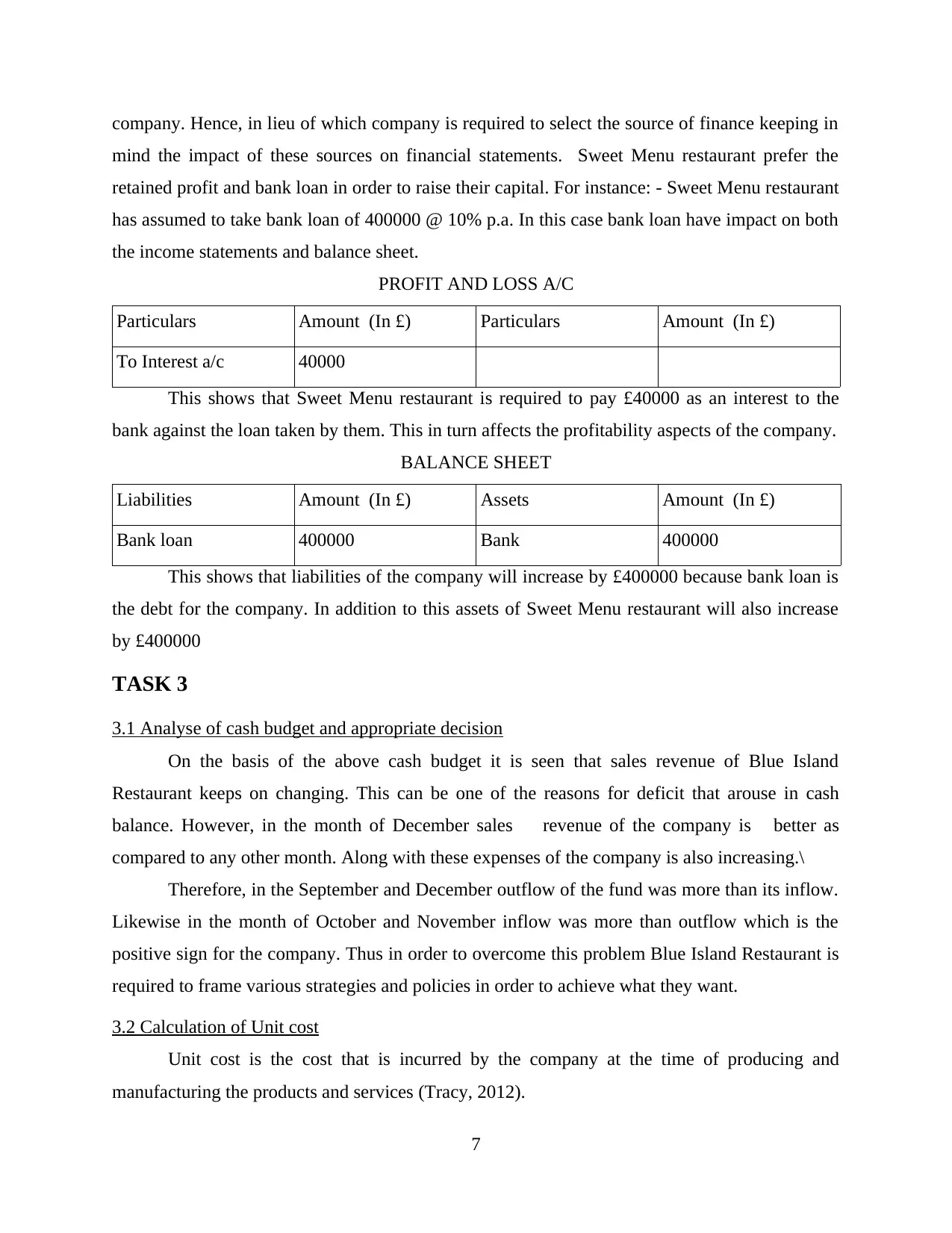
company. Hence, in lieu of which company is required to select the source of finance keeping in
mind the impact of these sources on financial statements. Sweet Menu restaurant prefer the
retained profit and bank loan in order to raise their capital. For instance: - Sweet Menu restaurant
has assumed to take bank loan of 400000 @ 10% p.a. In this case bank loan have impact on both
the income statements and balance sheet.
PROFIT AND LOSS A/C
Particulars Amount (In £) Particulars Amount (In £)
To Interest a/c 40000
This shows that Sweet Menu restaurant is required to pay £40000 as an interest to the
bank against the loan taken by them. This in turn affects the profitability aspects of the company.
BALANCE SHEET
Liabilities Amount (In £) Assets Amount (In £)
Bank loan 400000 Bank 400000
This shows that liabilities of the company will increase by £400000 because bank loan is
the debt for the company. In addition to this assets of Sweet Menu restaurant will also increase
by £400000
TASK 3
3.1 Analyse of cash budget and appropriate decision
On the basis of the above cash budget it is seen that sales revenue of Blue Island
Restaurant keeps on changing. This can be one of the reasons for deficit that arouse in cash
balance. However, in the month of December sales revenue of the company is better as
compared to any other month. Along with these expenses of the company is also increasing.\
Therefore, in the September and December outflow of the fund was more than its inflow.
Likewise in the month of October and November inflow was more than outflow which is the
positive sign for the company. Thus in order to overcome this problem Blue Island Restaurant is
required to frame various strategies and policies in order to achieve what they want.
3.2 Calculation of Unit cost
Unit cost is the cost that is incurred by the company at the time of producing and
manufacturing the products and services (Tracy, 2012).
7
mind the impact of these sources on financial statements. Sweet Menu restaurant prefer the
retained profit and bank loan in order to raise their capital. For instance: - Sweet Menu restaurant
has assumed to take bank loan of 400000 @ 10% p.a. In this case bank loan have impact on both
the income statements and balance sheet.
PROFIT AND LOSS A/C
Particulars Amount (In £) Particulars Amount (In £)
To Interest a/c 40000
This shows that Sweet Menu restaurant is required to pay £40000 as an interest to the
bank against the loan taken by them. This in turn affects the profitability aspects of the company.
BALANCE SHEET
Liabilities Amount (In £) Assets Amount (In £)
Bank loan 400000 Bank 400000
This shows that liabilities of the company will increase by £400000 because bank loan is
the debt for the company. In addition to this assets of Sweet Menu restaurant will also increase
by £400000
TASK 3
3.1 Analyse of cash budget and appropriate decision
On the basis of the above cash budget it is seen that sales revenue of Blue Island
Restaurant keeps on changing. This can be one of the reasons for deficit that arouse in cash
balance. However, in the month of December sales revenue of the company is better as
compared to any other month. Along with these expenses of the company is also increasing.\
Therefore, in the September and December outflow of the fund was more than its inflow.
Likewise in the month of October and November inflow was more than outflow which is the
positive sign for the company. Thus in order to overcome this problem Blue Island Restaurant is
required to frame various strategies and policies in order to achieve what they want.
3.2 Calculation of Unit cost
Unit cost is the cost that is incurred by the company at the time of producing and
manufacturing the products and services (Tracy, 2012).
7
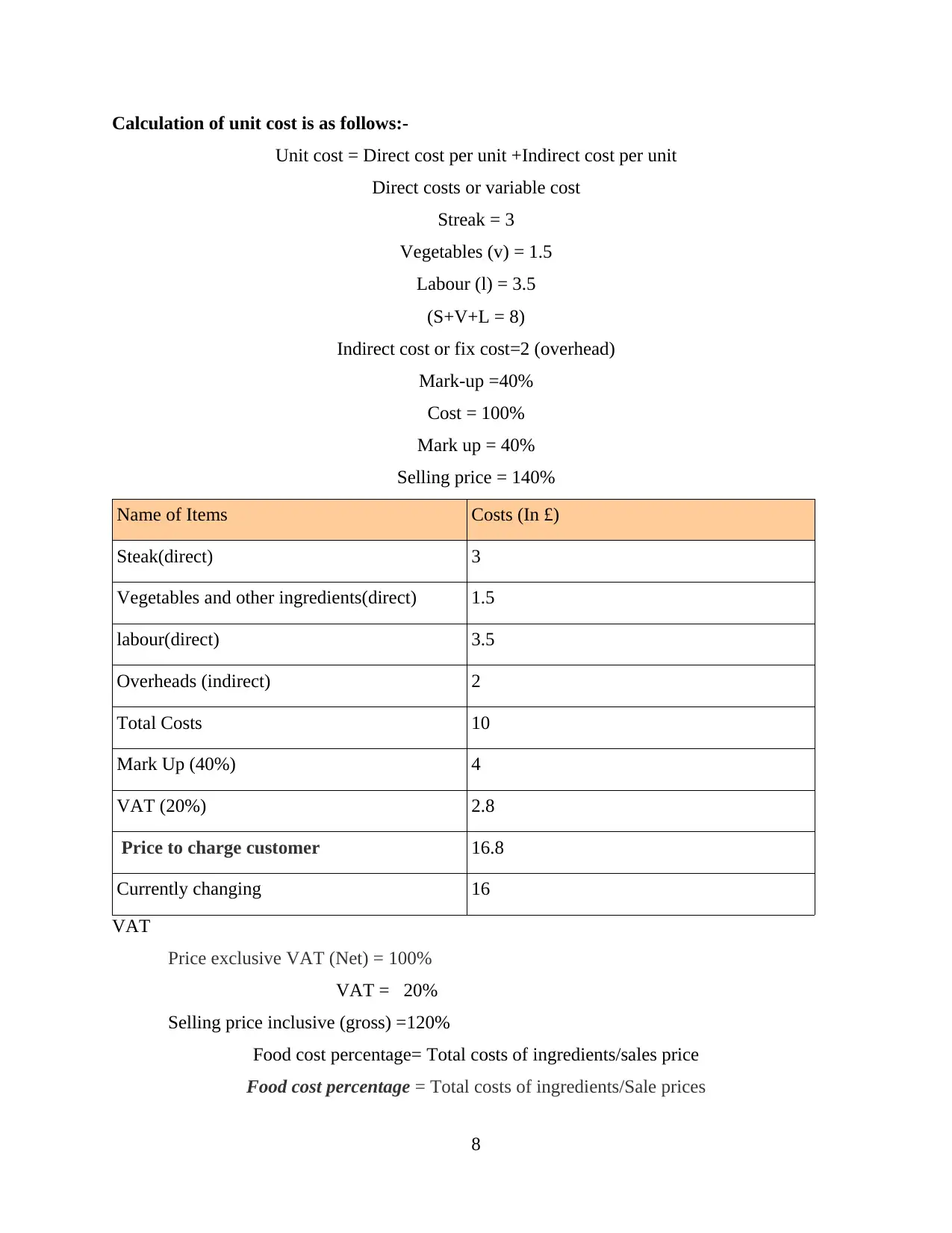
Calculation of unit cost is as follows:-
Unit cost = Direct cost per unit +Indirect cost per unit
Direct costs or variable cost
Streak = 3
Vegetables (v) = 1.5
Labour (l) = 3.5
(S+V+L = 8)
Indirect cost or fix cost=2 (overhead)
Mark-up =40%
Cost = 100%
Mark up = 40%
Selling price = 140%
Name of Items Costs (In £)
Steak(direct) 3
Vegetables and other ingredients(direct) 1.5
labour(direct) 3.5
Overheads (indirect) 2
Total Costs 10
Mark Up (40%) 4
VAT (20%) 2.8
Price to charge customer 16.8
Currently changing 16
VAT
Price exclusive VAT (Net) = 100%
VAT = 20%
Selling price inclusive (gross) =120%
Food cost percentage= Total costs of ingredients/sales price
Food cost percentage = Total costs of ingredients/Sale prices
8
Unit cost = Direct cost per unit +Indirect cost per unit
Direct costs or variable cost
Streak = 3
Vegetables (v) = 1.5
Labour (l) = 3.5
(S+V+L = 8)
Indirect cost or fix cost=2 (overhead)
Mark-up =40%
Cost = 100%
Mark up = 40%
Selling price = 140%
Name of Items Costs (In £)
Steak(direct) 3
Vegetables and other ingredients(direct) 1.5
labour(direct) 3.5
Overheads (indirect) 2
Total Costs 10
Mark Up (40%) 4
VAT (20%) 2.8
Price to charge customer 16.8
Currently changing 16
VAT
Price exclusive VAT (Net) = 100%
VAT = 20%
Selling price inclusive (gross) =120%
Food cost percentage= Total costs of ingredients/sales price
Food cost percentage = Total costs of ingredients/Sale prices
8
Secure Best Marks with AI Grader
Need help grading? Try our AI Grader for instant feedback on your assignments.
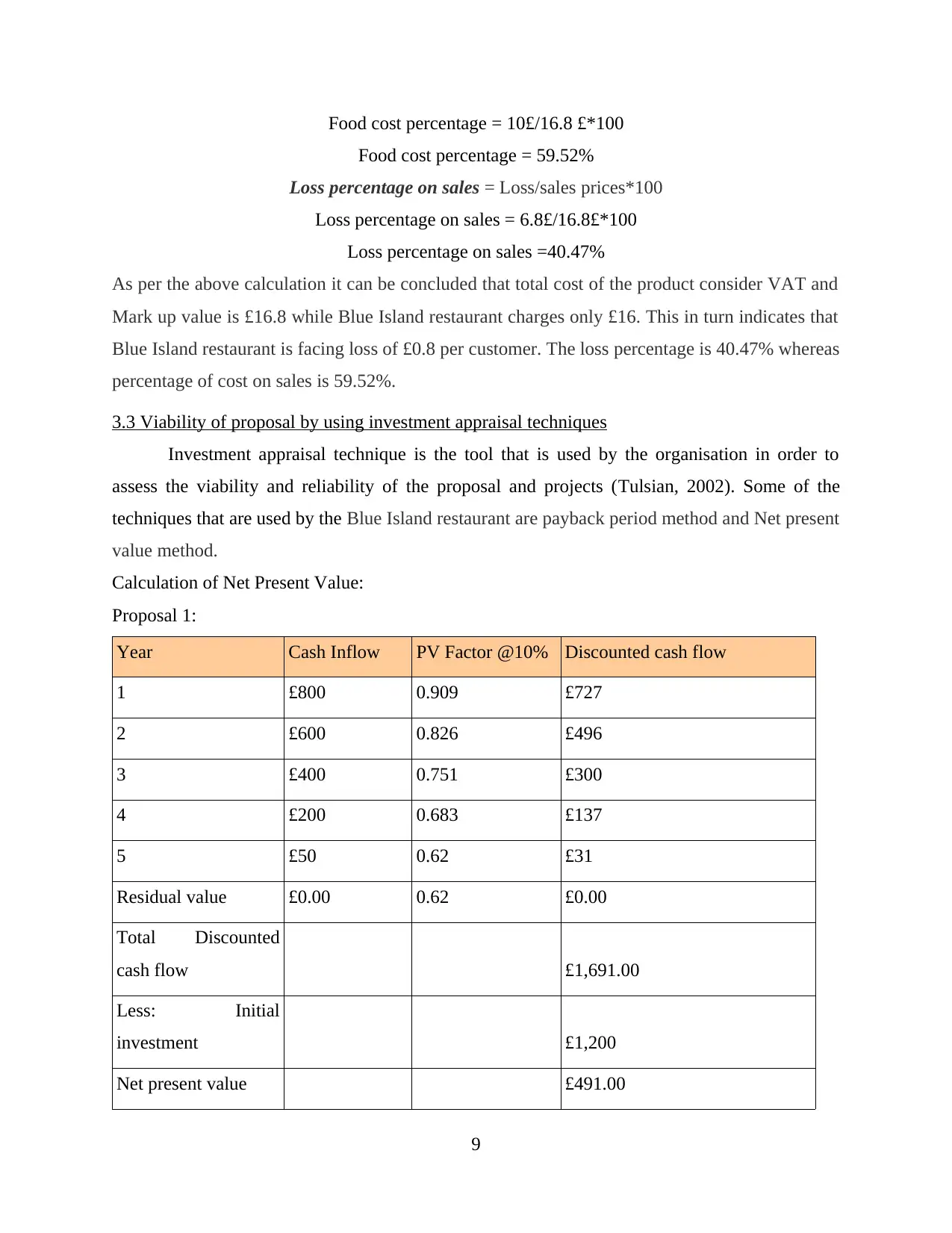
Food cost percentage = 10£/16.8 £*100
Food cost percentage = 59.52%
Loss percentage on sales = Loss/sales prices*100
Loss percentage on sales = 6.8£/16.8£*100
Loss percentage on sales =40.47%
As per the above calculation it can be concluded that total cost of the product consider VAT and
Mark up value is £16.8 while Blue Island restaurant charges only £16. This in turn indicates that
Blue Island restaurant is facing loss of £0.8 per customer. The loss percentage is 40.47% whereas
percentage of cost on sales is 59.52%.
3.3 Viability of proposal by using investment appraisal techniques
Investment appraisal technique is the tool that is used by the organisation in order to
assess the viability and reliability of the proposal and projects (Tulsian, 2002). Some of the
techniques that are used by the Blue Island restaurant are payback period method and Net present
value method.
Calculation of Net Present Value:
Proposal 1:
Year Cash Inflow PV Factor @10% Discounted cash flow
1 £800 0.909 £727
2 £600 0.826 £496
3 £400 0.751 £300
4 £200 0.683 £137
5 £50 0.62 £31
Residual value £0.00 0.62 £0.00
Total Discounted
cash flow £1,691.00
Less: Initial
investment £1,200
Net present value £491.00
9
Food cost percentage = 59.52%
Loss percentage on sales = Loss/sales prices*100
Loss percentage on sales = 6.8£/16.8£*100
Loss percentage on sales =40.47%
As per the above calculation it can be concluded that total cost of the product consider VAT and
Mark up value is £16.8 while Blue Island restaurant charges only £16. This in turn indicates that
Blue Island restaurant is facing loss of £0.8 per customer. The loss percentage is 40.47% whereas
percentage of cost on sales is 59.52%.
3.3 Viability of proposal by using investment appraisal techniques
Investment appraisal technique is the tool that is used by the organisation in order to
assess the viability and reliability of the proposal and projects (Tulsian, 2002). Some of the
techniques that are used by the Blue Island restaurant are payback period method and Net present
value method.
Calculation of Net Present Value:
Proposal 1:
Year Cash Inflow PV Factor @10% Discounted cash flow
1 £800 0.909 £727
2 £600 0.826 £496
3 £400 0.751 £300
4 £200 0.683 £137
5 £50 0.62 £31
Residual value £0.00 0.62 £0.00
Total Discounted
cash flow £1,691.00
Less: Initial
investment £1,200
Net present value £491.00
9
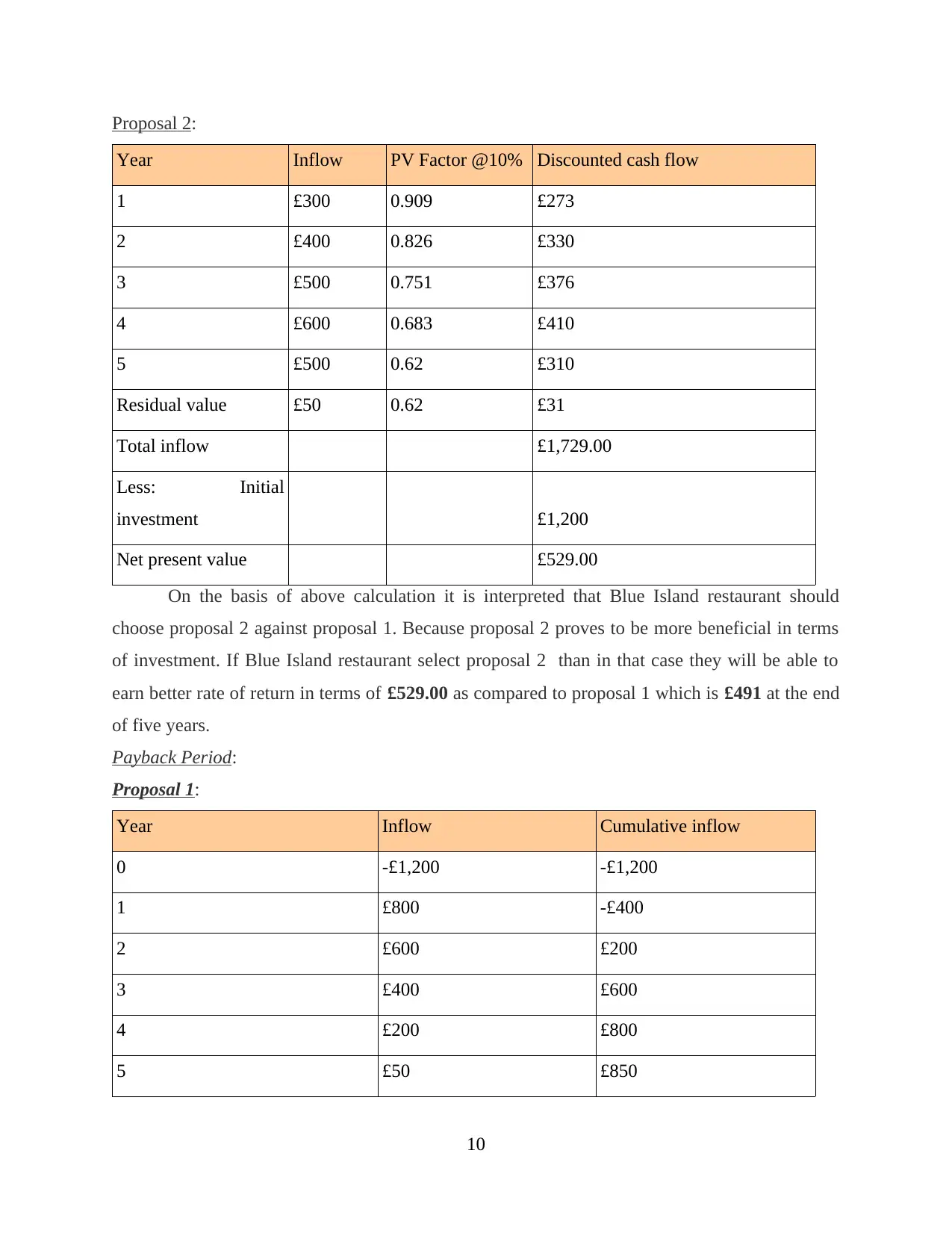
Proposal 2:
Year Inflow PV Factor @10% Discounted cash flow
1 £300 0.909 £273
2 £400 0.826 £330
3 £500 0.751 £376
4 £600 0.683 £410
5 £500 0.62 £310
Residual value £50 0.62 £31
Total inflow £1,729.00
Less: Initial
investment £1,200
Net present value £529.00
On the basis of above calculation it is interpreted that Blue Island restaurant should
choose proposal 2 against proposal 1. Because proposal 2 proves to be more beneficial in terms
of investment. If Blue Island restaurant select proposal 2 than in that case they will be able to
earn better rate of return in terms of £529.00 as compared to proposal 1 which is £491 at the end
of five years.
Payback Period:
Proposal 1:
Year Inflow Cumulative inflow
0 -£1,200 -£1,200
1 £800 -£400
2 £600 £200
3 £400 £600
4 £200 £800
5 £50 £850
10
Year Inflow PV Factor @10% Discounted cash flow
1 £300 0.909 £273
2 £400 0.826 £330
3 £500 0.751 £376
4 £600 0.683 £410
5 £500 0.62 £310
Residual value £50 0.62 £31
Total inflow £1,729.00
Less: Initial
investment £1,200
Net present value £529.00
On the basis of above calculation it is interpreted that Blue Island restaurant should
choose proposal 2 against proposal 1. Because proposal 2 proves to be more beneficial in terms
of investment. If Blue Island restaurant select proposal 2 than in that case they will be able to
earn better rate of return in terms of £529.00 as compared to proposal 1 which is £491 at the end
of five years.
Payback Period:
Proposal 1:
Year Inflow Cumulative inflow
0 -£1,200 -£1,200
1 £800 -£400
2 £600 £200
3 £400 £600
4 £200 £800
5 £50 £850
10
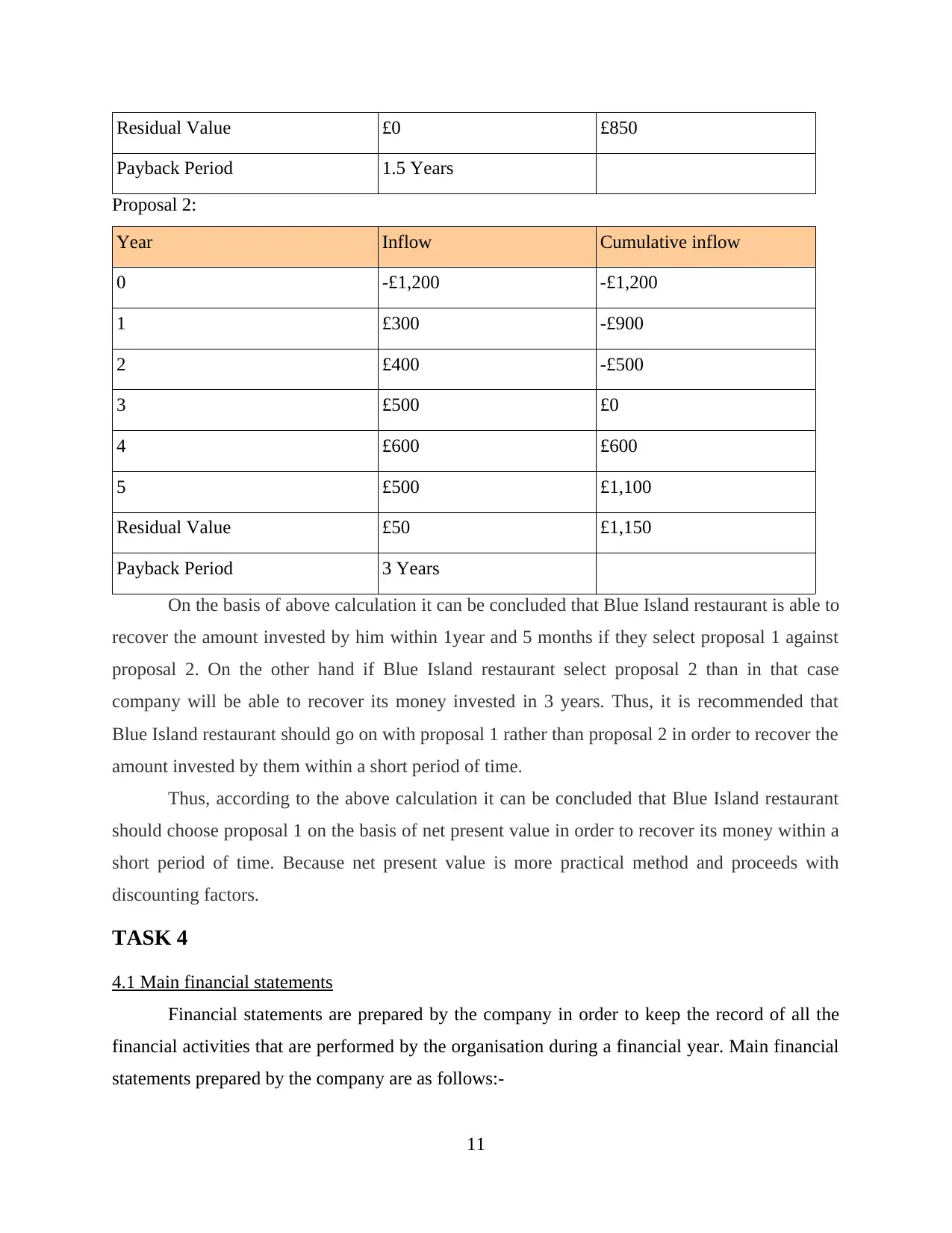
Residual Value £0 £850
Payback Period 1.5 Years
Proposal 2:
Year Inflow Cumulative inflow
0 -£1,200 -£1,200
1 £300 -£900
2 £400 -£500
3 £500 £0
4 £600 £600
5 £500 £1,100
Residual Value £50 £1,150
Payback Period 3 Years
On the basis of above calculation it can be concluded that Blue Island restaurant is able to
recover the amount invested by him within 1year and 5 months if they select proposal 1 against
proposal 2. On the other hand if Blue Island restaurant select proposal 2 than in that case
company will be able to recover its money invested in 3 years. Thus, it is recommended that
Blue Island restaurant should go on with proposal 1 rather than proposal 2 in order to recover the
amount invested by them within a short period of time.
Thus, according to the above calculation it can be concluded that Blue Island restaurant
should choose proposal 1 on the basis of net present value in order to recover its money within a
short period of time. Because net present value is more practical method and proceeds with
discounting factors.
TASK 4
4.1 Main financial statements
Financial statements are prepared by the company in order to keep the record of all the
financial activities that are performed by the organisation during a financial year. Main financial
statements prepared by the company are as follows:-
11
Payback Period 1.5 Years
Proposal 2:
Year Inflow Cumulative inflow
0 -£1,200 -£1,200
1 £300 -£900
2 £400 -£500
3 £500 £0
4 £600 £600
5 £500 £1,100
Residual Value £50 £1,150
Payback Period 3 Years
On the basis of above calculation it can be concluded that Blue Island restaurant is able to
recover the amount invested by him within 1year and 5 months if they select proposal 1 against
proposal 2. On the other hand if Blue Island restaurant select proposal 2 than in that case
company will be able to recover its money invested in 3 years. Thus, it is recommended that
Blue Island restaurant should go on with proposal 1 rather than proposal 2 in order to recover the
amount invested by them within a short period of time.
Thus, according to the above calculation it can be concluded that Blue Island restaurant
should choose proposal 1 on the basis of net present value in order to recover its money within a
short period of time. Because net present value is more practical method and proceeds with
discounting factors.
TASK 4
4.1 Main financial statements
Financial statements are prepared by the company in order to keep the record of all the
financial activities that are performed by the organisation during a financial year. Main financial
statements prepared by the company are as follows:-
11
Paraphrase This Document
Need a fresh take? Get an instant paraphrase of this document with our AI Paraphraser
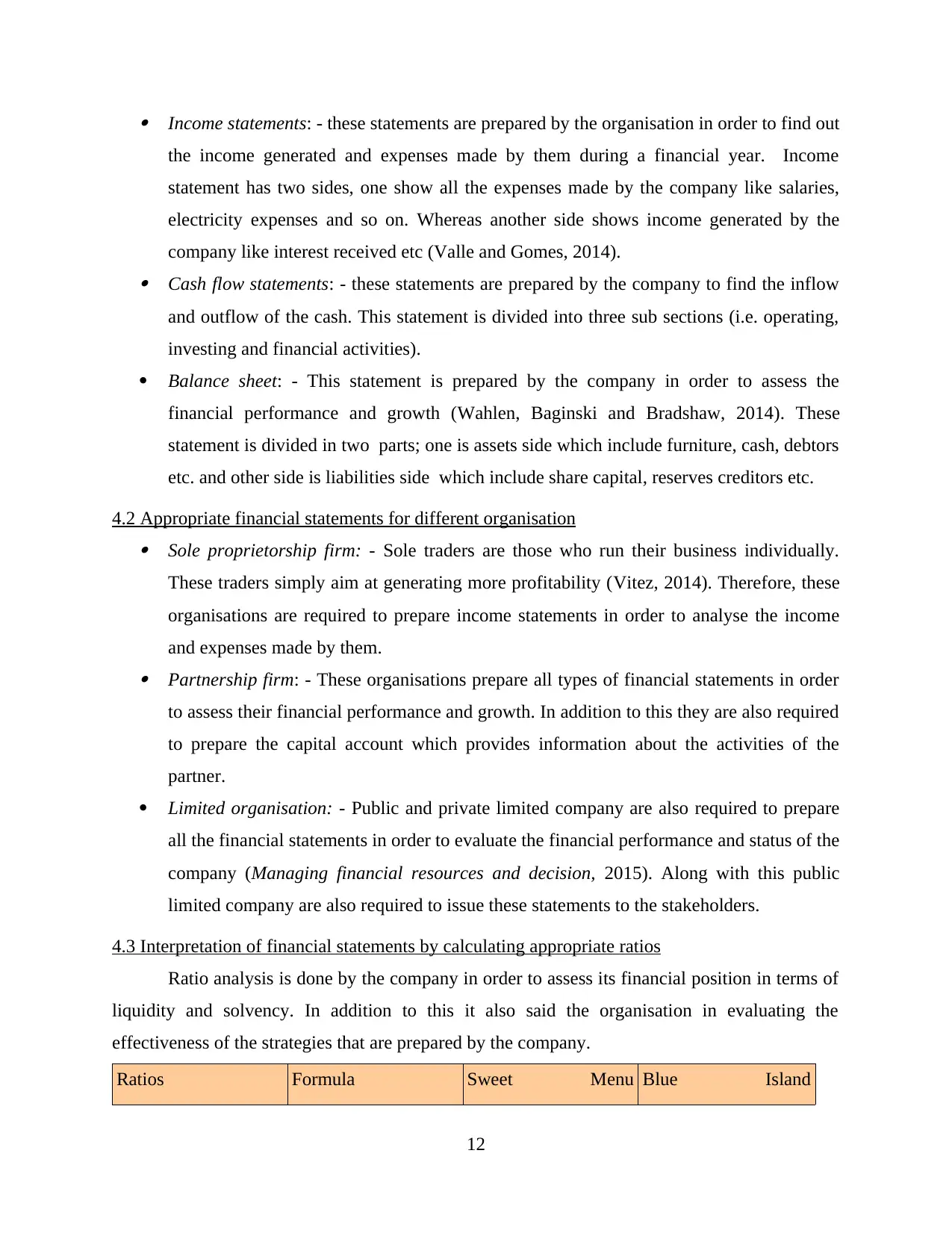
Income statements: - these statements are prepared by the organisation in order to find out
the income generated and expenses made by them during a financial year. Income
statement has two sides, one show all the expenses made by the company like salaries,
electricity expenses and so on. Whereas another side shows income generated by the
company like interest received etc (Valle and Gomes, 2014). Cash flow statements: - these statements are prepared by the company to find the inflow
and outflow of the cash. This statement is divided into three sub sections (i.e. operating,
investing and financial activities).
Balance sheet: - This statement is prepared by the company in order to assess the
financial performance and growth (Wahlen, Baginski and Bradshaw, 2014). These
statement is divided in two parts; one is assets side which include furniture, cash, debtors
etc. and other side is liabilities side which include share capital, reserves creditors etc.
4.2 Appropriate financial statements for different organisation Sole proprietorship firm: - Sole traders are those who run their business individually.
These traders simply aim at generating more profitability (Vitez, 2014). Therefore, these
organisations are required to prepare income statements in order to analyse the income
and expenses made by them. Partnership firm: - These organisations prepare all types of financial statements in order
to assess their financial performance and growth. In addition to this they are also required
to prepare the capital account which provides information about the activities of the
partner.
Limited organisation: - Public and private limited company are also required to prepare
all the financial statements in order to evaluate the financial performance and status of the
company (Managing financial resources and decision, 2015). Along with this public
limited company are also required to issue these statements to the stakeholders.
4.3 Interpretation of financial statements by calculating appropriate ratios
Ratio analysis is done by the company in order to assess its financial position in terms of
liquidity and solvency. In addition to this it also said the organisation in evaluating the
effectiveness of the strategies that are prepared by the company.
Ratios Formula Sweet Menu Blue Island
12
the income generated and expenses made by them during a financial year. Income
statement has two sides, one show all the expenses made by the company like salaries,
electricity expenses and so on. Whereas another side shows income generated by the
company like interest received etc (Valle and Gomes, 2014). Cash flow statements: - these statements are prepared by the company to find the inflow
and outflow of the cash. This statement is divided into three sub sections (i.e. operating,
investing and financial activities).
Balance sheet: - This statement is prepared by the company in order to assess the
financial performance and growth (Wahlen, Baginski and Bradshaw, 2014). These
statement is divided in two parts; one is assets side which include furniture, cash, debtors
etc. and other side is liabilities side which include share capital, reserves creditors etc.
4.2 Appropriate financial statements for different organisation Sole proprietorship firm: - Sole traders are those who run their business individually.
These traders simply aim at generating more profitability (Vitez, 2014). Therefore, these
organisations are required to prepare income statements in order to analyse the income
and expenses made by them. Partnership firm: - These organisations prepare all types of financial statements in order
to assess their financial performance and growth. In addition to this they are also required
to prepare the capital account which provides information about the activities of the
partner.
Limited organisation: - Public and private limited company are also required to prepare
all the financial statements in order to evaluate the financial performance and status of the
company (Managing financial resources and decision, 2015). Along with this public
limited company are also required to issue these statements to the stakeholders.
4.3 Interpretation of financial statements by calculating appropriate ratios
Ratio analysis is done by the company in order to assess its financial position in terms of
liquidity and solvency. In addition to this it also said the organisation in evaluating the
effectiveness of the strategies that are prepared by the company.
Ratios Formula Sweet Menu Blue Island
12
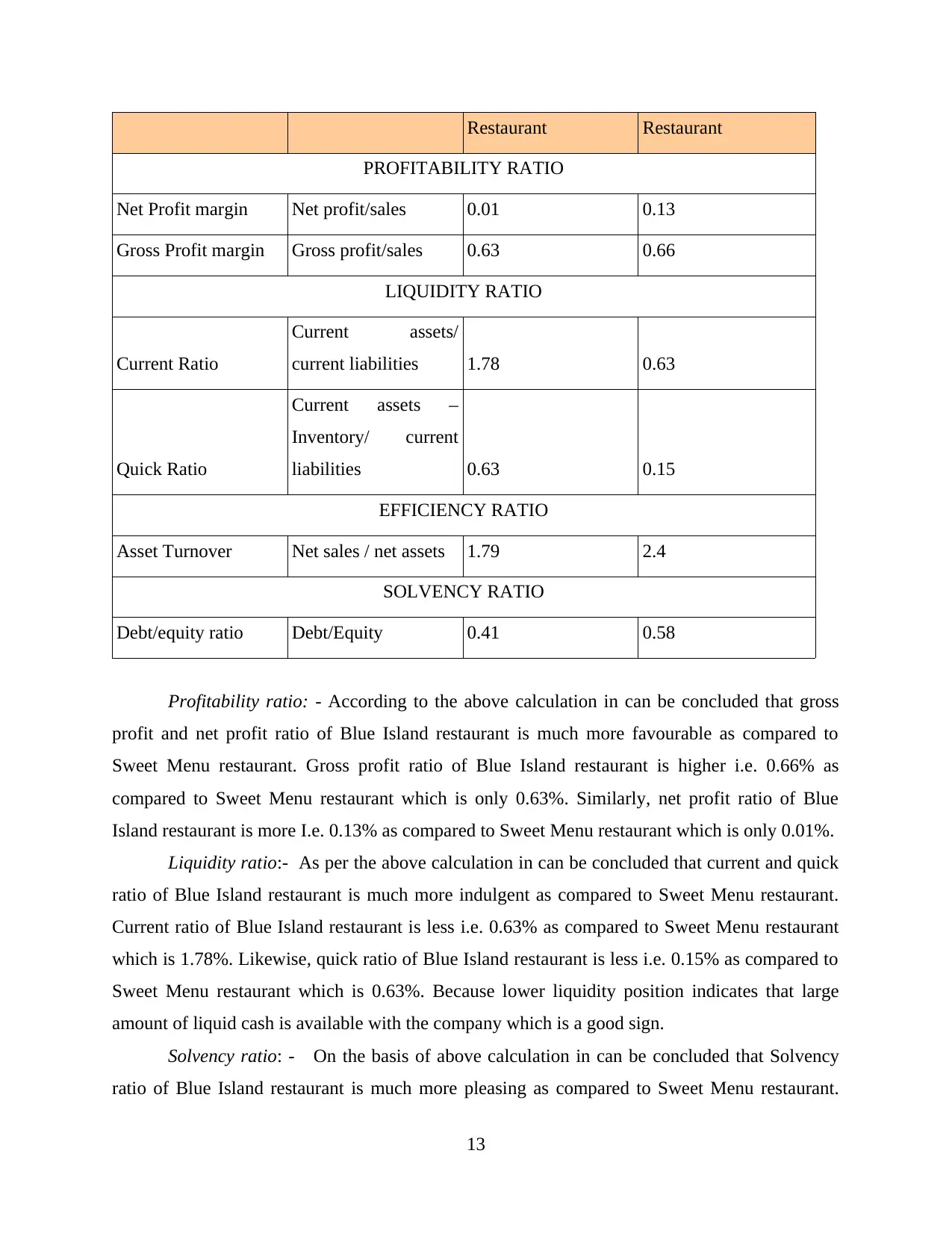
Restaurant Restaurant
PROFITABILITY RATIO
Net Profit margin Net profit/sales 0.01 0.13
Gross Profit margin Gross profit/sales 0.63 0.66
LIQUIDITY RATIO
Current Ratio
Current assets/
current liabilities 1.78 0.63
Quick Ratio
Current assets –
Inventory/ current
liabilities 0.63 0.15
EFFICIENCY RATIO
Asset Turnover Net sales / net assets 1.79 2.4
SOLVENCY RATIO
Debt/equity ratio Debt/Equity 0.41 0.58
Profitability ratio: - According to the above calculation in can be concluded that gross
profit and net profit ratio of Blue Island restaurant is much more favourable as compared to
Sweet Menu restaurant. Gross profit ratio of Blue Island restaurant is higher i.e. 0.66% as
compared to Sweet Menu restaurant which is only 0.63%. Similarly, net profit ratio of Blue
Island restaurant is more I.e. 0.13% as compared to Sweet Menu restaurant which is only 0.01%.
Liquidity ratio:- As per the above calculation in can be concluded that current and quick
ratio of Blue Island restaurant is much more indulgent as compared to Sweet Menu restaurant.
Current ratio of Blue Island restaurant is less i.e. 0.63% as compared to Sweet Menu restaurant
which is 1.78%. Likewise, quick ratio of Blue Island restaurant is less i.e. 0.15% as compared to
Sweet Menu restaurant which is 0.63%. Because lower liquidity position indicates that large
amount of liquid cash is available with the company which is a good sign.
Solvency ratio: - On the basis of above calculation in can be concluded that Solvency
ratio of Blue Island restaurant is much more pleasing as compared to Sweet Menu restaurant.
13
PROFITABILITY RATIO
Net Profit margin Net profit/sales 0.01 0.13
Gross Profit margin Gross profit/sales 0.63 0.66
LIQUIDITY RATIO
Current Ratio
Current assets/
current liabilities 1.78 0.63
Quick Ratio
Current assets –
Inventory/ current
liabilities 0.63 0.15
EFFICIENCY RATIO
Asset Turnover Net sales / net assets 1.79 2.4
SOLVENCY RATIO
Debt/equity ratio Debt/Equity 0.41 0.58
Profitability ratio: - According to the above calculation in can be concluded that gross
profit and net profit ratio of Blue Island restaurant is much more favourable as compared to
Sweet Menu restaurant. Gross profit ratio of Blue Island restaurant is higher i.e. 0.66% as
compared to Sweet Menu restaurant which is only 0.63%. Similarly, net profit ratio of Blue
Island restaurant is more I.e. 0.13% as compared to Sweet Menu restaurant which is only 0.01%.
Liquidity ratio:- As per the above calculation in can be concluded that current and quick
ratio of Blue Island restaurant is much more indulgent as compared to Sweet Menu restaurant.
Current ratio of Blue Island restaurant is less i.e. 0.63% as compared to Sweet Menu restaurant
which is 1.78%. Likewise, quick ratio of Blue Island restaurant is less i.e. 0.15% as compared to
Sweet Menu restaurant which is 0.63%. Because lower liquidity position indicates that large
amount of liquid cash is available with the company which is a good sign.
Solvency ratio: - On the basis of above calculation in can be concluded that Solvency
ratio of Blue Island restaurant is much more pleasing as compared to Sweet Menu restaurant.
13
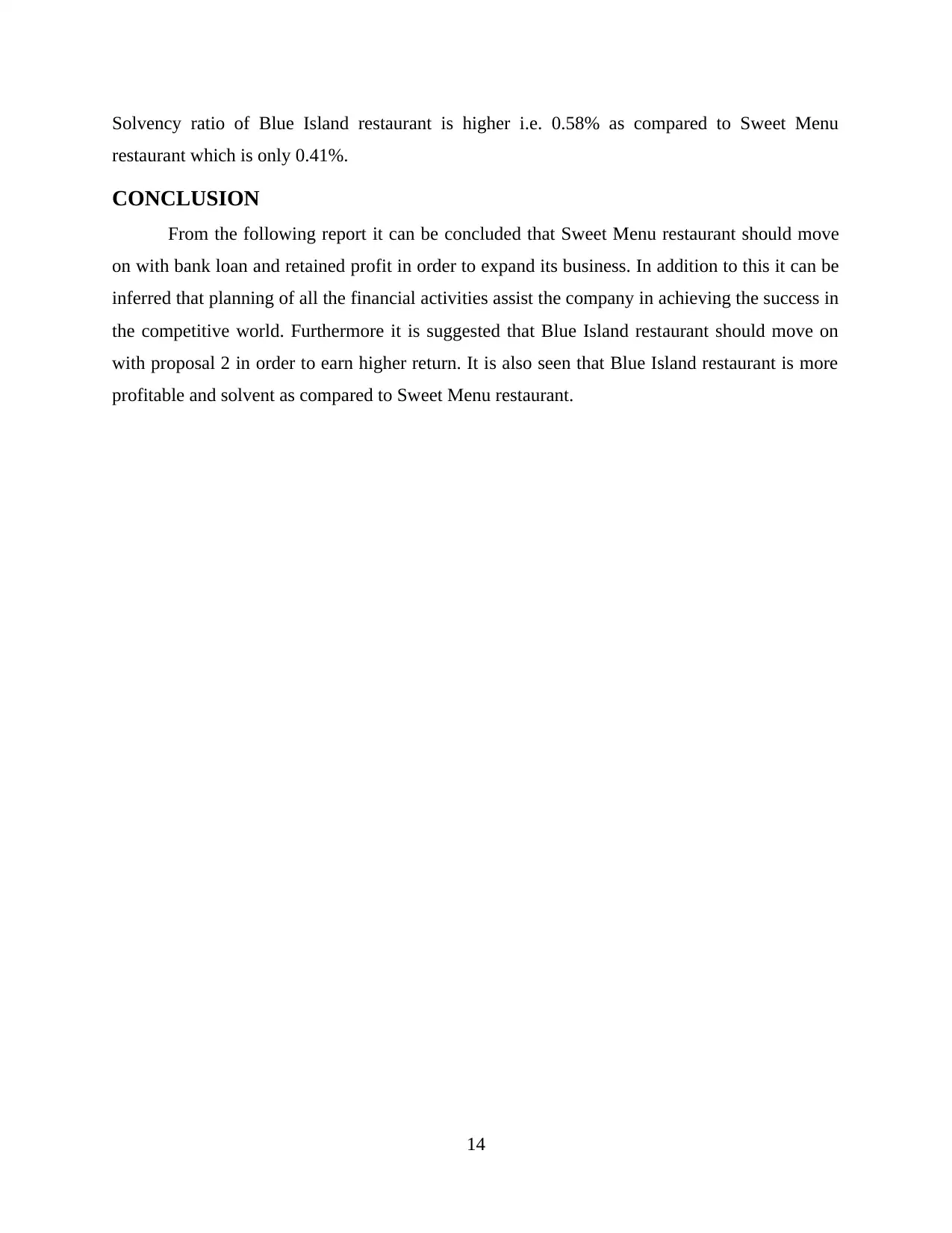
Solvency ratio of Blue Island restaurant is higher i.e. 0.58% as compared to Sweet Menu
restaurant which is only 0.41%.
CONCLUSION
From the following report it can be concluded that Sweet Menu restaurant should move
on with bank loan and retained profit in order to expand its business. In addition to this it can be
inferred that planning of all the financial activities assist the company in achieving the success in
the competitive world. Furthermore it is suggested that Blue Island restaurant should move on
with proposal 2 in order to earn higher return. It is also seen that Blue Island restaurant is more
profitable and solvent as compared to Sweet Menu restaurant.
14
restaurant which is only 0.41%.
CONCLUSION
From the following report it can be concluded that Sweet Menu restaurant should move
on with bank loan and retained profit in order to expand its business. In addition to this it can be
inferred that planning of all the financial activities assist the company in achieving the success in
the competitive world. Furthermore it is suggested that Blue Island restaurant should move on
with proposal 2 in order to earn higher return. It is also seen that Blue Island restaurant is more
profitable and solvent as compared to Sweet Menu restaurant.
14
Secure Best Marks with AI Grader
Need help grading? Try our AI Grader for instant feedback on your assignments.
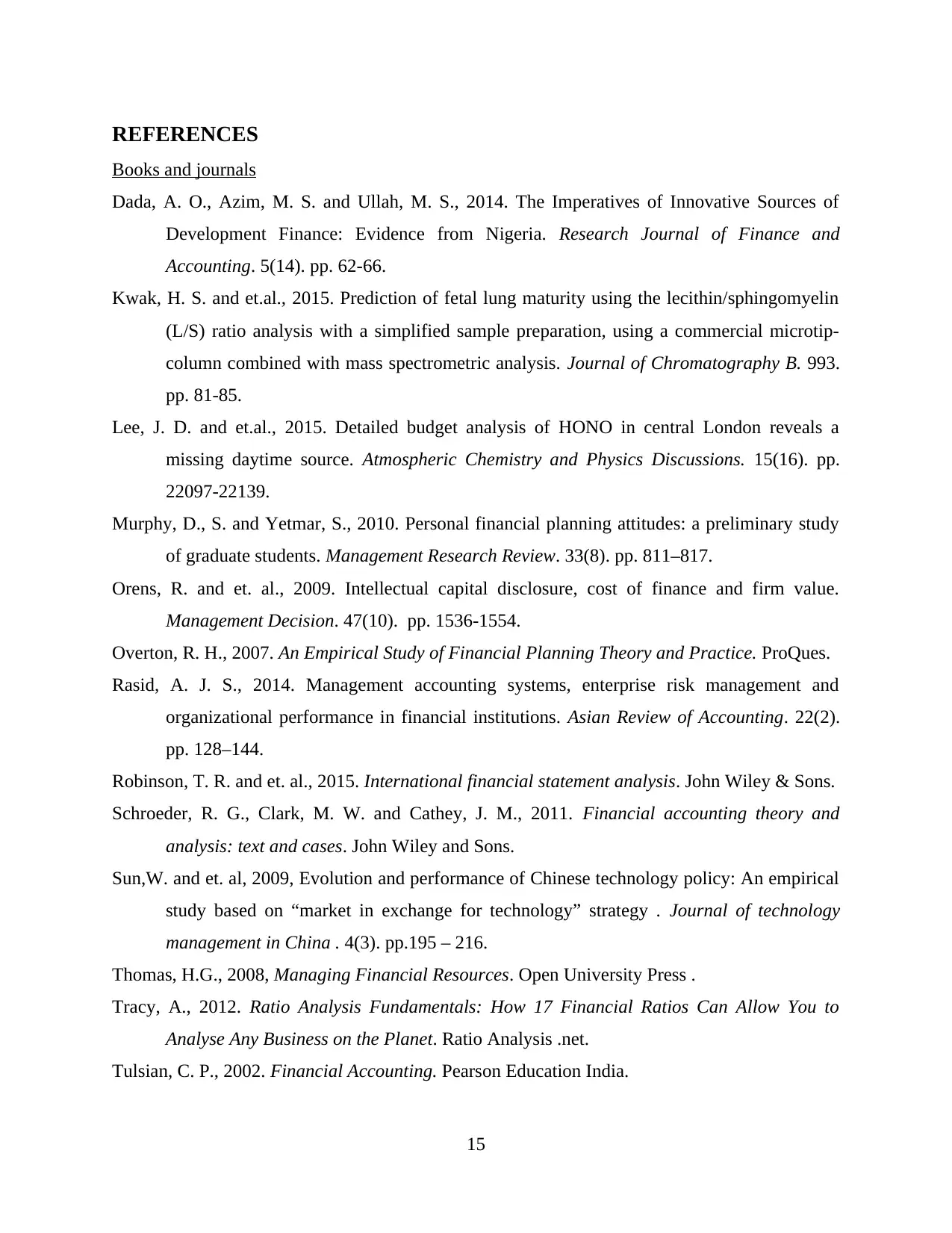
REFERENCES
Books and journals
Dada, A. O., Azim, M. S. and Ullah, M. S., 2014. The Imperatives of Innovative Sources of
Development Finance: Evidence from Nigeria. Research Journal of Finance and
Accounting. 5(14). pp. 62-66.
Kwak, H. S. and et.al., 2015. Prediction of fetal lung maturity using the lecithin/sphingomyelin
(L/S) ratio analysis with a simplified sample preparation, using a commercial microtip-
column combined with mass spectrometric analysis. Journal of Chromatography B. 993.
pp. 81-85.
Lee, J. D. and et.al., 2015. Detailed budget analysis of HONO in central London reveals a
missing daytime source. Atmospheric Chemistry and Physics Discussions. 15(16). pp.
22097-22139.
Murphy, D., S. and Yetmar, S., 2010. Personal financial planning attitudes: a preliminary study
of graduate students. Management Research Review. 33(8). pp. 811–817.
Orens, R. and et. al., 2009. Intellectual capital disclosure, cost of finance and firm value.
Management Decision. 47(10). pp. 1536-1554.
Overton, R. H., 2007. An Empirical Study of Financial Planning Theory and Practice. ProQues.
Rasid, A. J. S., 2014. Management accounting systems, enterprise risk management and
organizational performance in financial institutions. Asian Review of Accounting. 22(2).
pp. 128–144.
Robinson, T. R. and et. al., 2015. International financial statement analysis. John Wiley & Sons.
Schroeder, R. G., Clark, M. W. and Cathey, J. M., 2011. Financial accounting theory and
analysis: text and cases. John Wiley and Sons.
Sun,W. and et. al, 2009, Evolution and performance of Chinese technology policy: An empirical
study based on “market in exchange for technology” strategy . Journal of technology
management in China . 4(3). pp.195 – 216.
Thomas, H.G., 2008, Managing Financial Resources. Open University Press .
Tracy, A., 2012. Ratio Analysis Fundamentals: How 17 Financial Ratios Can Allow You to
Analyse Any Business on the Planet. Ratio Analysis .net.
Tulsian, C. P., 2002. Financial Accounting. Pearson Education India.
15
Books and journals
Dada, A. O., Azim, M. S. and Ullah, M. S., 2014. The Imperatives of Innovative Sources of
Development Finance: Evidence from Nigeria. Research Journal of Finance and
Accounting. 5(14). pp. 62-66.
Kwak, H. S. and et.al., 2015. Prediction of fetal lung maturity using the lecithin/sphingomyelin
(L/S) ratio analysis with a simplified sample preparation, using a commercial microtip-
column combined with mass spectrometric analysis. Journal of Chromatography B. 993.
pp. 81-85.
Lee, J. D. and et.al., 2015. Detailed budget analysis of HONO in central London reveals a
missing daytime source. Atmospheric Chemistry and Physics Discussions. 15(16). pp.
22097-22139.
Murphy, D., S. and Yetmar, S., 2010. Personal financial planning attitudes: a preliminary study
of graduate students. Management Research Review. 33(8). pp. 811–817.
Orens, R. and et. al., 2009. Intellectual capital disclosure, cost of finance and firm value.
Management Decision. 47(10). pp. 1536-1554.
Overton, R. H., 2007. An Empirical Study of Financial Planning Theory and Practice. ProQues.
Rasid, A. J. S., 2014. Management accounting systems, enterprise risk management and
organizational performance in financial institutions. Asian Review of Accounting. 22(2).
pp. 128–144.
Robinson, T. R. and et. al., 2015. International financial statement analysis. John Wiley & Sons.
Schroeder, R. G., Clark, M. W. and Cathey, J. M., 2011. Financial accounting theory and
analysis: text and cases. John Wiley and Sons.
Sun,W. and et. al, 2009, Evolution and performance of Chinese technology policy: An empirical
study based on “market in exchange for technology” strategy . Journal of technology
management in China . 4(3). pp.195 – 216.
Thomas, H.G., 2008, Managing Financial Resources. Open University Press .
Tracy, A., 2012. Ratio Analysis Fundamentals: How 17 Financial Ratios Can Allow You to
Analyse Any Business on the Planet. Ratio Analysis .net.
Tulsian, C. P., 2002. Financial Accounting. Pearson Education India.
15
1 out of 17
Related Documents
Your All-in-One AI-Powered Toolkit for Academic Success.
+13062052269
info@desklib.com
Available 24*7 on WhatsApp / Email
![[object Object]](/_next/static/media/star-bottom.7253800d.svg)
Unlock your academic potential
© 2024 | Zucol Services PVT LTD | All rights reserved.





